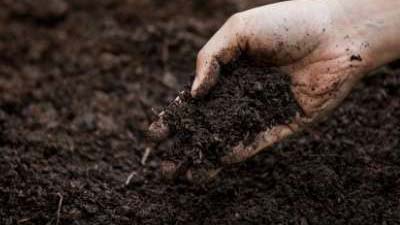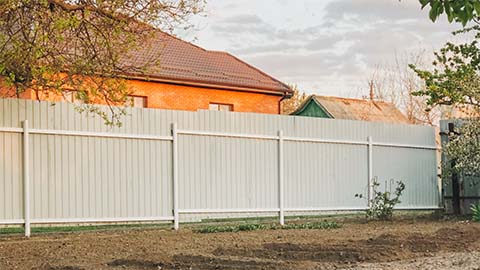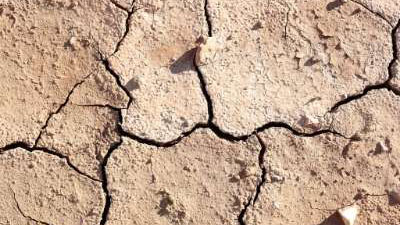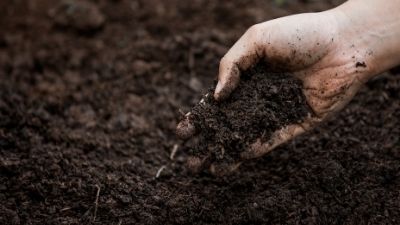Preparing and Improving Garden Soil

A great garden starts with healthy soil. In Utah, there are unique considerations for creating and maintaining healthy soils.
Native Utah soils are relatively low in organic matter. Soils along the Wasatch Front average 1.5% organic matter content, whereas areas of the country that receive more rainfall typically have 4-5%. The pH of Utah soils averages 8.0, which is ten times more alkaline than a neutral pH of 7. Alkaline soils cause certain micronutrients to become less available, leading to nutrient deficiencies in garden plants. One of Utah’s most troublesome, pH-related deficiencies is iron chlorosis, a deficiency of plant-available iron. Lastly, soil salinity easily increases in Utah. Keeping soil salinity below 2 dS/m is ideal for most garden plants. Despite these challenges, time and organic matter can transform garden soils from brutal to beautiful!
Organic matter is a broad, umbrella term that describes sources of carbon-containing materials, such as kitchen scraps, leaves, wood, manure, grass clippings, or even dead materials in the soil, such as decomposed plant and animal tissue. Organic matter is the best amendment for any soil type. It increases soil moisture retention, improves structure, and decreases compaction. Soil structure is the aggregation of the mineral portion of the soil with organic matter. Many Utah soils can have poor soil structure due to heavy clay subsoils and low organic matter. Adding organic matter helps form secondary particles that allow air and water movement into the soil. Good structure also improves the tilth or workability of soil, ultimately improving plant growth. Organic matter also provides essential nutrients, as well as food and habitat to many soil macro- and microorganisms. These soil flora and fauna create important soil health benefits, such as improved aeration, soil structure, and nutrient cycling. Hence, organic matter is often referred to as “black gold.”
Types of Organic Matter
Compost
Compost is decomposed organic matter that no longer resembles the original parent material. It looks and smells earthy, like rich garden soil. It is typically incorporated into annual gardens and surface-applied with perennials.
Mulch
Mulch, such as shredded bark or hay, is applied to the soil surface to reduce weeds, protect trees and shrubs, reduce evaporation, moderate soil temperature, or beautify the landscape. It is usually not fully decomposed.
Livestock Manure
Livestock manure, particularly when mixed with straw bedding, can also increase soil organic matter. Avoid using dog, cat, or other manure from meat-eating animals because, unless they are hot composted, these materials carry some risk of pathogen spread to humans.
Not all mulches or amendments are organic. Inorganic mulches include rocks, glass, and plastic. Examples of inorganic amendments are perlite, pumice, vermiculite, and Utelite. These products improve the drainage and aeration, but do not add nutrients
Soil Testing
The addition of some organic amendments, such as compost or manures, will also supply plant nutrients. While these amendments increase soil fertility, they usually do not supply appropriate plant nutrition when used alone.
It is important to have soil tested before incorporating composts and animal manures because these amendments are naturally high in phosphorus (P) and potassium (K). Over-application of soil nutrients, especially nitrogen and phosphorus, may contaminate water sources including lakes and streams or leach into groundwater. Over-application of K can increase soil salinity. Soil can be tested through USU’s Analytical Laboratory. Pricing and information for collecting and submitting a sample is available here. Table 1 lists organic matter types and their approximate nutrient analysis.
Sewage Sludge
Sewage sludge (bio solids) can also be a soil amendment. Sewage sludge is a by-product of treated wastewater and contains organic matter in addition to some contaminants and pathogens. To address these risks, the U.S. EPA adopted regulations in 1993 that set minimum standards for concentration limits of nine metals and pathogens for land applied sewage sludge. Multiple studies have been performed to assess the risks and benefits of using sewage sludge in the garden. For more information on sewage sludge, access the Cornell Waste Management Institute.
Table 1: Organic matter sources and approximate nutrient analyses as % Nitrogen, % Phosphate, and % Potash
| Plant Materials | |||
|---|---|---|---|
| Source | % Nitrogen | % Phosphate | % Potash |
| Grass clippings | 1-2 | 0-0.5 | 1-2 |
| Leaves | 1 | 0-0.5 | 0-0.5 |
| Legumes | 2-4 | 0-0.5 | 2-3 |
| Pine needles | 0.5 | 0 | 1 |
| Sawdust | 0-1 | 0-0.5 | 0-1 |
| Composts | |||
|---|---|---|---|
| Source | % Nitrogen | % Phosphate | % Potash |
| Chicken manure-based | 1.4 | 5.8 | 2.8 |
| Horse manure-based | 0.7 | 0.3 | 0.9 |
| Sheep manure-based | 1.0 | 1.1 | 1.3 |
| Municipal | 1.2 | 1.1 | 0.7 |
| Plant-based | 1.4 | 0.9 | 0.9 |
| Manures | |||
|---|---|---|---|
| Source | % Nitrogen | % Phosphate | % Potash |
| Beef | 0.9 | 0.6 | 1.1 |
| Chicken | 2.0 | 2.7 | 1.4 |
| Goat | 0.4 | 0.5 | 0.1 |
| Horse | 0.7 | 0.4 | 1.1 |
| Sheep | 1.0 | 0.5 | 1.0 |
Amending Garden Soil
One common mistake gardeners make when amending soil is expecting immediate results. Garden soils improve over time. Incorporating 1-2 inches of organic matter into the soil annually will gradually - and sustainably - improve soil quality and reduce the risk for excessive salinity and nutrient levels. Avoid amending clay with sand. Organic matter is a preferable soil amendment.
Incorporating Organic Matter
There are several ways to incorporate organic matter into the garden. These include rotary tillers or other mechanical implements, which help mix organic matter deeper into the soil. Double-digging is another option, which describes soil that is dug from an area of the garden, mixed with organic matter, and returned to the same area. Some gardeners choose to avoid tilling or digging by spreading organic matter on the soil surface to slowly decompose and incorporate into the soil. This method takes longer and can lead to nutrient buildup at the surface, but is appropriate for perennial plants and the patient gardener.
Organic matter can be added in the spring or fall, but only incorporate it when the soil is not wet. Tilling wet soil creates compaction and hard pan formation in clay soils. Annual replenishment is critical because Utah garden soils constantly lose organic matter. How much organic matter is needed? One inch per year prevents a net loss, but 2 inches of low-salt organic matter helps build your soil.
Adding materials that are not fully decomposed including leaves, sawdust, wood shavings, or straw often ties up soil nitrogen. Avoid nitrogen deficiency (stunted, pale yellow plants) by adding one pound (1 pt) of ammonium sulfate (21-0-0) per each 1 inch of organic material per 100 square feet (10 foot by 10 foot area).
Cover crops are an alternative way to increase soil organic matter. They have many added benefits, such as weed suppression, nutrient scavenging, and soil erosion protection. Cover crops called legumes can also supply nitrogen. Unlike manures and some composts, cover crops do not increase soil salinity or create excessive P and K levels. Terminate cover crops with hand pulling, appropriate herbicides, or mowing. Cover crops can then be left as a surface mulch or incorporated into the soil through tillage.
Sources of Organic Amendments
There are several sources of organic amendments, including many inexpensive and free options! Mulched leaves and grass clippings from the lawn are both wonderful sources of organic matter. They are free and abundant, but can contain weeds. Homemade compost from kitchen scraps is also a wonderful amendment option that is usually low in salts. Wood chips can be purchased or collected from tree care companies. Compost can be purchased from local garden centers, landfills, or companies that specialize in compost products. Never add lime or wood ash to Utah soils. Add gypsum only when trying to reclaim a sodic soil (a soil with excess sodium) that has been verified by a lab test.
Disclaimers
All photos and tables should not be used without written permission from the authors. Fig. 1, 3, & 5: K. Wagner; Fig. 2 & 4: L. Sagers; Fig. 6, 7, & Banner: M. Stock.
Additional Resources
- Card, A., D. Whiting, C. Wilson, and J. Reeder. 2011. Organic Fertilizers.
- Cornell Waste Management Institute. 2007. Sewage Sludge (aka Sewage Biosolids).
- Cox, L. and R. Koenig. 2010. Solutions to Soil Problems II. High pH (alkaline soil).
- Hatch, D. 1990. Preparing Garden Soil. Heaton, K. and R. Koenig. 2010. Solutions to Soil Problems V. Low Organic Matter.
- Johnson, M. and R. Koenig. 2010. Solutions to Soil Problems III. Drainage.
- Johnson, M., M. Wolf, and R. Koenig. 2010. Cover Crops for Utah Gardens.
- Koenig, R. and T. Cerny. 2010. Solutions to Soil Problems IV. Soil Structure (compaction).
- Koenig, R. and M. Johnson. 2011. Selecting and Using Organic Fertilizers.
- Parent, V. and R. Koenig. 2010. Solutions to Soil Problems I. Soil Salinity.
- Stock, M., T. Maughan, and R. Miller. 2019. Sustainable Manure and Compost Application: Garden and Micro Farm Guidelines.
Utah State University Extension
Peer-reviewed fact sheet
Download PDF
Authors
Katie Wagner, Melanie Stock, and Larry Sagers
Related Research














